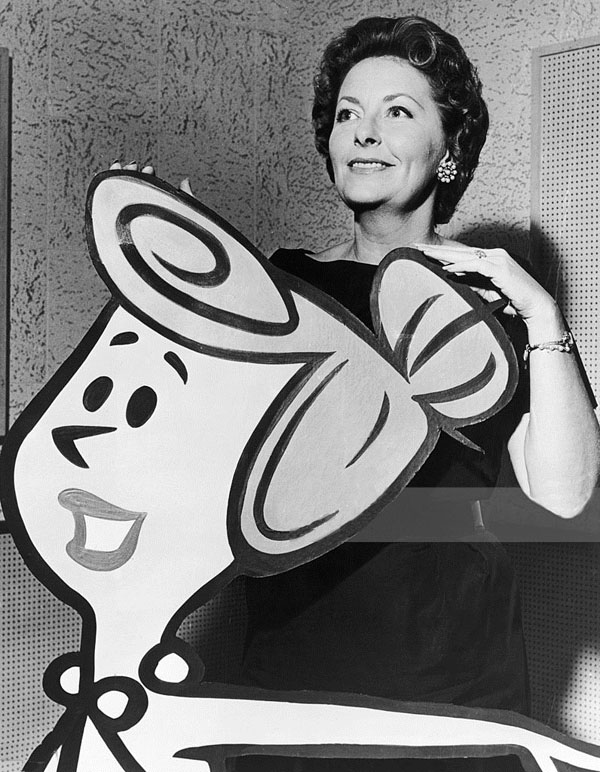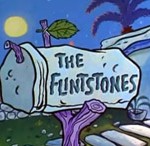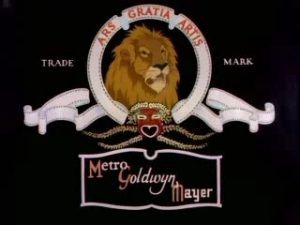
Jean Vander Pyl Remembers The Flinstones. From the Asbury Park Press newspaper May 15, 1994 in a series of columns by Mark Voger, voice actress Jean Vander Pyl shared the following:
“I was never very bold about telling directors what I wanted. You just didn’t do that in those days. But there were two times that I did.
“When Bea Benaderet, an old friend, and I were reading for Joe Barbera (for The Flintstones), it was the funniest thing. We read back and forth, this way and that way. Finally, Joe said ‘Who wants to be Wilma and who wants to be Betty?’ it was so informal in those days, so much more relaxed. Today, they would never do such a thing. So I said, ‘Oh, I want to be Wilma!’ I felt a real closeness to that character. Bea said, ‘That’s fine with me’. So that was actually the way it was cast.

Alan Reed and Jean Vander Pyl
“I worked in radio for twenty years. For radio people, if you couldn’t do more than one character in a show, you didn’t work. So cartoons were a natural for radio people. My first role for Hanna-Barbera was as Mrs. Creply in a Snooper and Blabbermouth episode. She looked very much like the mother in The Addams Family. So I thought, ‘What can I do?’ I fiddled with it and came up with in my own way of thinking, as actors do, half Katherine Hepburn and half Tallulah Bankhead if you can imagine.
“They (Hanna and Barbera) showed us the drawing (of the Flintstones cast) and Mr. Barbera explained to us what it was like. He said, ‘It’s sort of like The Honeymooners. And that was the tip-off to what type of voices they wanted. So, all four of us had a pattern that we were lead into. I did sort of an impression of Audrey Meadows who played the wife on The Honeymooners which was that New York nasal kind of thing. All up in the nose.
“So when we all first started we all ended up doing almost impressions of those four. But then, after we got the parts and the show was on, I remember Joe saying to me ‘Jean that’s a little too nasal. Let’s cut down on the nasal’. But I would slip into it, because we had done several shows that way. So it became half me and half the original Wilma.”
 Hanna on the The Flintstones. In February 1993, Bill Hanna who was then 82 years old was interviewed in USA Today by Jefferson Graham about the latest The Flintstones special where Pebbles gets married. Hanna said, “Fred, Wilma and Barney went on the air in 1960 and they’ve stayed on, constantly, ever since. They’re still running today because the basic concept (a Stone Age family) afforded a lot of gags. Using your feet to start your car, using an elephant’s trunk to take a shower. My favorite is Fred because he’s explosive; he yells and hollers yet he’s also tender and funny.”
Hanna on the The Flintstones. In February 1993, Bill Hanna who was then 82 years old was interviewed in USA Today by Jefferson Graham about the latest The Flintstones special where Pebbles gets married. Hanna said, “Fred, Wilma and Barney went on the air in 1960 and they’ve stayed on, constantly, ever since. They’re still running today because the basic concept (a Stone Age family) afforded a lot of gags. Using your feet to start your car, using an elephant’s trunk to take a shower. My favorite is Fred because he’s explosive; he yells and hollers yet he’s also tender and funny.”
Walworth at MGM. John C. “Wally” Walworth Jr. is perhaps best known for creating memorable premiums (sometimes in cereal boxes) for a variety of characters and firms. However, he got his start in animation including a short stint at MGM in 1938 after two weeks working as an in-betweener on the Oswald the Rabbit series for Walter Lantz.
 “I had been living in Hollywood and now MGM was in Culver City. First, I had to figure where the hell that was and second, how I was going to get there since I didn’t have a car. I ran into a friend who told me if I stood out in front of the Mark Twain Hotel, I could probably catch a ride with some of the guys from Terrytoons.
“I had been living in Hollywood and now MGM was in Culver City. First, I had to figure where the hell that was and second, how I was going to get there since I didn’t have a car. I ran into a friend who told me if I stood out in front of the Mark Twain Hotel, I could probably catch a ride with some of the guys from Terrytoons.
“It was an animation outfit from New Rochelle out in California working for MGM. It was owned by Paul Terry of whom it was said that he had more money than God – he owned half of New Rochelle. Anyway, that morning, I bummed a ride with Joe Barbera, later of Hanna-Barbera fame.
“I was one of three assistant to animator Leonard Sebring. I was making $22.50 a week. In the spring of 1938, Fleischer offered me a job at $35.00 a week. When they added transportation back to New York, I tendered my resignation at MGM.”
Animated Aquino. In 1994, Ruben Aquino, the key animator for the adult Simba in Disney’s The Lion King (1994) said in a publicity interview, “I approach every scene as any live action actor would. I meet with the director and ask, ‘What’s my attitude in this scene? What do I want, hope fear?’ Then I draw quick thumbnail sketches of major poses that help me capture the basic emotions of the scene. I discuss the sketches with the director, then it’s ‘back to the drawing board’.”
 Chuck Jones on Cartoon Violence. In US magazine for November 1992, animation legend Chuck Jones said, “Our cartoons have aired since 1957 (on television). I’d like to see a study done of people who grew up watching a half hour of uncut Warner cartoons every week. I don’t think you’ll find any psychopaths.”
Chuck Jones on Cartoon Violence. In US magazine for November 1992, animation legend Chuck Jones said, “Our cartoons have aired since 1957 (on television). I’d like to see a study done of people who grew up watching a half hour of uncut Warner cartoons every week. I don’t think you’ll find any psychopaths.”
The Fleischer Victory Newsreel. In May 1932, singer Helen Kane filed a $250,000 infringement lawsuit against Max Fleischer and Paramount Publix Corporation for the “deliberate caricature” that produced “unfair competition”. She lost when it was determined she had borrowed her character and “boop boop a doop” from other performers.
Kane had witnessed an African American performer, Baby Esther using a similar vocal style in an act at the Cotton Club in Harlem, some years earlier. An early test sound film was also discovered, which featured Baby Esther performing in this style.
The Fleischer Studios Victory Newsreel which runs thirteen seconds features Little Ann Little, Bonnie Poe, Mae Questel (standing in the center) and Margie Hines and Kate Wright with a triumphant Max Fleischer sitting in front. These five performers had done Betty Boop.


 Jim Korkis is an internationally respected animation historian who in recent years has devoted his attention to the many worlds of Disney. He was a columnist for a variety of animation magazines. With his former writing partner, John Cawley, he authored several animation related books including The Encyclopedia of Cartoon Superstars, How to Create Animation, Cartoon Confidential and Get Animated’s Animation Art Buyer’s Guide. He taught animation classes at the Disney Institute in Florida as well as instructing classes on acting and animation history for Disney Feature Animation: Florida.
Jim Korkis is an internationally respected animation historian who in recent years has devoted his attention to the many worlds of Disney. He was a columnist for a variety of animation magazines. With his former writing partner, John Cawley, he authored several animation related books including The Encyclopedia of Cartoon Superstars, How to Create Animation, Cartoon Confidential and Get Animated’s Animation Art Buyer’s Guide. He taught animation classes at the Disney Institute in Florida as well as instructing classes on acting and animation history for Disney Feature Animation: Florida.




















































What’s weird is, on The Flintstones, Fred was the one with the fiery temperament – but in I Yabba Dabba Do! Wilma had a more fiery temperament that’s more volatile than Fred’s! (It included a scene where Wilma was literally shoving a wedding photo of her and Fred with a Elvis impersonator – which didn’t made any sense due to Elvis was around in The original run of The Flintstones) – and how she attacked Fred (with the help of her buttinski neanderthalic Mother Pearl Slaghoople) when Fred tried to tell Wilma about the bad news (about how they couldn’t afford Pebbles ‘elaborate and costly wedding to Bamm Bamm). Hence the English lyrics to Owe Thörnqvist’s Wilma from the narrator’s point of view, on how Wilma mistreated Fred and how he felt unsafe going to the Flintstones home (“I rather go tackle a Brontosaurus than deal with his wife!”)
And on ‘cartoon violence’ – it wasn’t until the 1980’s when parental watchdog groups such as the Parental Television Council,The Action on Children’s Television and others are ripping the classic theatrical cartoons of the past wanting to censor or ban them from broadcast on television. Case in point the now infamous “committing suicide with a gun” scene such as in several cartoons – which included The Stupid Cupid, The Bob Clampett version of Horton Hatches a Egg, Ballot Box Bunny, Tortoise Wins By a Hare, Hare Ribbin, Fraidy Cat, The Scarlet Pumpernickel and many others. Suprised that in the Tiny Toon episode Her Wacky Highness where Babs’ class clown antics cause Professor Elmer Fudd to send Babs to the Principal’s office and making the class take a pop quiz because of her and in that one scene shows Buster Bunny faking a suicide by pretending to blow his head off by pointing his finger in a gun like shape and simulating a sound of a gun going off. Surprised that those parental watchdog groups weren’t freaked out after that scene was shown.
I had heard that the suicide gags in the old Warner cartoons were eliminated by order of Ted Turner, whose father, Atlanta billboard builder Ed Turner, died by his own hand.
I don’t like that direction they went in with the Flintstones specials in later years. Wilma was always shrill because they took away her personality and just used her as a foil to Fred who was always disapproving of whatever he was doing and not much more. Betty fared little better. It was just the guys having adventures.
And on ‘cartoon violence’ – it wasn’t until the 1980’s when parental watchdog groups such as the Parental Television Council,The Action on Children’s Television and others are ripping the classic theatrical cartoons of the past wanting to censor or ban them from broadcast on television.
Uh, Action for Children’s Television had been around and had been very busy since the mid-1960s. ACT is the reason why the Warner cartoons were suddenly being sliced and diced for Saturday morning broadcasts of THE BUGS BUNNY SHOW back then. They’re the reason why CBS dumped Tom and Jerry in 1972 and why MGM chose to sit on the films for several years before releasing them into syndication. Groups like Action for Children’s Television were campaigning against cartoon violence long before the 1980s.
I have a sales brochure from ABC Films for the Beany and Cecil cartoons, issued when the series was first released into syndication in the late 1960s, intended to persuade local stations to pick up the films. One of the things that interests me about this brochure is that it spends a lot of time talking about how non-violent the Beany and Cecil cartoons were, which isn’t strictly true, but saying it may have eased the minds of a few TV program directors.
Fun stuff, as always, Jim!
What happened to the ‘hip’ new colorful layout experiment in AA #314 and #315? Too much extra work? Or did the American Optometric Association frown on it?
It hurt my eyes. 😉
Yeah I just noticed the slight format change here, still, not bad Jerry, I don’t mind the headers being ALL CAPS!
More on “Cartoon Violence ”
First, a classic Rocky and Bulwinkle cartoon where Bullwinkle was talking about violence and a TV Executive (voiced by Paul Frees) was using every single known violent act on Bullwinkle from bashing him over the head with a mallet to shooting him with a cannon – and asking him why he loved violence so much, Bullwinkle’s responded “Because they smell good!” And of course he was referring to VIOLETS and not VIOLENCE!
Second, the writers were having a field day on the Parental Watchdog Groups who were blasting cartoons because of their violent contents. One was The Simpsons episode Itchy,Scratchy and Marge – where Marge Simpson created the watchdog group S.N.U.H. (Springfieldians for Nonviolent, Understanding and Helping) to combat the ultra violent Itchy and Scratchy cartoons, after Homer got attacked by Maggie after she watched the cartoons. And in The Anvil Chorus from the Tiny Toons episode It’s Buster Bunny Time and later in Washingtoon where the Chairperson from the watchdog group Adults Against Funny Cartoons (AAFC) where at first tries to intervene when Plucky Duck was getting clobbered by falling anvils before she got clobbered herself and tried to eradicate all the wacky humor and violence from Acme Acres.
Third, there was a gag on the Casper the Friendly Ghost cartoon Ghost Writers (1958) where in a glass door box with a pistol and a sign saying “In Case if You’re Fired” which suggests the person who was terminated to take their own live by committing suicide by gun – sadly it now takes a totally different meaning in today’s society.
@Brian
Kind of surprising that Action for Children Television didn’t rip the Children’s Television Workshop for a cartoon that many considered the most violent cartoon ever to be shown on Sesame Street. The cartoon in question was the B-Bug cartoon, where a lady in a Bun hairdo was showing the letter B until a bug shows up, she blasts the bug with bug spray and the bug counterattacks with a cannon blasting her.
ACT first attacked the Boston edition of Romper Room, who promoted toy products on their show.
By the late 1960s ACT targeted Hanna Barbera’s The Herculoids, Space Ghost, Birdman and the Galaxy Trio, The Fantastic Four and DFE’s Super President – and by 1970 were responsible of having these series pulled from television. (Space Ghost and the Herculoids returned in the 1980s in Space Stars and the Fantastic Four returned in 1979 by DFE Productions and also in 1994 and in 2006).
Cartoon violence? The boomers who grew up with hours of old cartoon shorts on a daily basis ‘toons intended for weekly consumption in theaters and fed in hour doses on TV, begat the Anti-War Movement. Sure,lots of reasons why(the draft,the immorality,the futileness of closure)but remember these kids were likely weaned on hundreds of guns to the face,exploding cannon balls,anvils dropped and folks falling off of high places and yet wanted to do no harm to a living creature. For myself,the more ‘toons I digested,the less I wanted to fight. Leave it to Popeye & the Road Runner. I’ll watch.
Probably because Cecil- or one of the other characters- often pointed out in an aside, when too much mayhem was happening on screen, “Do you think there’s too much violence on television?”.
“Harecules Hare” (in “Harecules and the Golden Fleecing”) points out the fact to the viewer, when we can’t see the “Guided Muscle” beating up “William Shakespeare Wolf”, “Attention! In deference to Mr. Minow {Newton W. Minow, FCC chairman who publicly scolded the TV networks for showing too much violence in 1961}, we must go underground for our violence!”